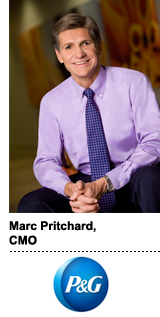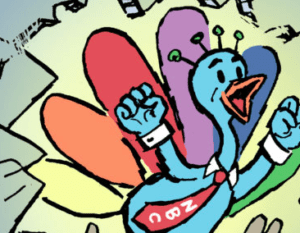 Programmatic ad buying is an inexorable and positive progression for the marketing industry, according to Global Marketing Officer Marc Pritchard of Procter & Gamble, the world’s largest advertiser.
Programmatic ad buying is an inexorable and positive progression for the marketing industry, according to Global Marketing Officer Marc Pritchard of Procter & Gamble, the world’s largest advertiser.
“[Programmatic] is inevitable, and we’re definitely interested,” Pritchard told AdExchanger on Thursday. “It enables you to more precisely target, and do it at a very valuable price, and then get a nice business lift from it.”
But Pritchard says the automation trend has created a host of problems requiring urgent attention – among them ad fraud, viewability and the hidden rebates agencies procure from publishers.
“Despite the tremendous creative and business potential enabled by digital technology, value is being eroded through financial and operational lapses in the media supply chain,” Pritchard told an audience of fellow marketers at the ANA Media Leadership conference in Hollywood, Fla.
As for his stance on viewability?
“Last I checked, an impression was a measure of viewability,” Pritchard said. “What exactly is an unviewable impression? And why would any advertiser in their right mind pay for that?”
Despite the challenges in digital, P&G is reaping its benefits. The company is taking a “digital-first approach to building brands,” Pritchard said, currently riding the wave of its “Like A Girl” campaign for Always, which went from a digital, viral success to a Super Bowl ad.
After seeing the campaign resonate on digital, P&G’s agency cut the three-minute, 19-second spot into a 60-second Super Bowl ad supported by paid digital media across search, social, display, video and mobile.
Pritchard (who also serves as vice chairman of the ANA) spoke with AdExchanger.
AdExchanger: How is P&G evolving its measurement approach?
MARC PRITCHARD: We work with internal and external partners to figure out how to find the right attribution for an act that leads to a sale. If more publishers can offer that and more suppliers or more partners and media agencies can offer that, that will make it easier too. That makes it so we’re focused on the outcome together … as opposed to trying to measure everything.
[The technology] either exists or it could be developed. If we’re clear about what we’re trying to accomplish, which is connecting our brand-building acts to the ultimate outcome of sales, I’m sure someone can do that.
Analytics are a major part of what we’re about, and it’s an obvious part of what the industry is moving toward. We’ve always used some form of analysis to understand what consumers are doing, so we can create brands, products and ideas that will create value for consumers. And the good news is now there’s more data available, and more analytics capability to do that.
Is that data something that lives only inside P&G, or are you giving that to publishers, partners or agencies?
It always has existed, and will still exist, at several steps throughout the supply chain. It’s smarter to ensure that you work across different partners, different approaches, because the technology is changing so rapidly, so we’re trying different things, and working across different platforms or partners.
What role does first-party data have in what P&G does?
We’ve had first-party data from the very beginning when we pioneered consumer market research, going door to door asking consumers questions. We use first-party research and first-party data to understand what consumers are doing, their behaviors, attitudes, practices. That’s something we’re deeply committed to as a company. One of our core strengths is consumer understanding –how you understand that first-level data to gain insight, to create ideas and opportunities to more effectively target.
For many of the emerging digital channels, the audience comes first and then the marketing dollars. How are you approaching some of these channels that have the audiences but are still looking for dollars?
To commercialize digital media, it needs to be at a high enough reach so it makes sense for an advertiser to target and use as an advertising platform. Then you have to figure out how to do the creative work to make that a decent experience that creates value for the consumer, and therefore the advertiser and the medium.
We experiment, and we try to identify partners where we see consumers gravitating and translate that into some kind of programming. That’s exactly what we did with Facebook, Google, YouTube, Instagram.
What new parts of media are you excited about?
I’m very excited about where the mobile revolution will take us. I think that will provide a whole range of opportunities. I’m excited about where TV will go, and I don’t know where it will be. It’s obvious that TV technology can transform with digital technology, in some point in the future.
What are you doing around addressable or connected TV?
I wouldn’t want to divulge too much. Let’s just say – addressable, programmatic, automation – it’s inevitable. So we’re interested. And we’ll work with partners to see where it takes us.
Last year, it was reported that P&G had the goal of spending 70% of its ad budget this year on programmatic. What are you doing there?
We didn’t express that specific goal, but it’s just like what I said about addressable. It’s inevitable, and we’re definitely interested. The reason why is that it creates more value. It creates value for the consumers, and therefore creates value for the publisher and for the advertisers/brands. It enables you to more precisely target, and do it at a very valuable price, and then get a nice business lift from it.
P&G has a renewed focus on its beauty brands. What are you doing there, especially in the digital space or using data?
Cover Girl is a good example of leveraging the combination of creativity plus data-driven marketing. Our Grammys activation with Katy Perry was classic. Most of that was digital, and involved targeting consumers through understanding where they were and figuring out how we could best reach them through Facebook and YouTube and Instagram – Instagram was huge – as well as TV. Cover Girl is probably one of our best brands at effectively doing that.
With Facebook reducing the organic reach of posts on its platform, have you changed your strategy there?
No, because what’s important is great creative that is well-targeted. That is going to produce better value for both consumers and the company. If it’s brilliant creative, it gets shared. So it keeps putting the emphasis back on coming up with a great brand idea that expresses the brand promises that is targeted to the right consumers. If they like it, they will share it and then get the earned media that comes along with it.
What actions is P&G taking that you can share around issues like fraud and viewability and trust that you hope others will follow?
The first and most important is trying to elevate everything to focus on the consumer experience. That means ensuring we can target consumers with ads or content that they want to see when they want to see it, and get the right creative so we can engage them in an effective way and that will end up leading to sales.
Then we want to create value throughout the supply chain, whether you’re an agency, publisher supplier or ad server. The rest of it is the partners we choose – we trust our partners – and the way we operate. We’re transparent, they’re very transparent and that’s what others need to do.
If you get too hung up on the in-process metrics or the technologies or transactions, you lose sight of what we’re trying to do, which is create value for consumers. When you focus on the end outcome for consumers that leads to trials and sales, the rest of it takes care of itself.
Publicis Chief Strategist Rishad Tobaccowla spoke yesterday about the “walled garden” issue with large platforms operated by Facebook and Google. Do these walled gardens work against your brands’ best interests? How are you working around that?
It’s an interesting thought, and it will probably be one of those debates that rages on for several years. There’s a lot of data out there that enables us to figure out how to best reach consumers and engage with them. It’s a matter of figuring out how to navigate through those three different sources, available, walled and first-party, and use those resources effectively. Where data exists, we get it from [available] sources. Where it’s walled, we work with the publisher to get the data, or work with them to do specific levels of targeting based on their capabilities.













